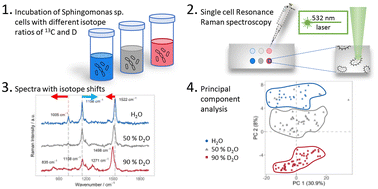Multi-element stable isotope Raman microspectroscopy of bacterial carotenoids unravels rare signal shift patterns and single-cell phenotypic heterogeneity†
Abstract
The combination of single-cell Raman microspectroscopy (SCRM) and stable isotope probing (SIP) enables in situ tracking of carbon or hydrogen fluxes into microorganisms at the single-cell level. Therefore, it has high potential for the analysis of metabolic processes and biogeochemical cycles. However, especially for high throughput applications such as imaging or cell sorting, it is hampered by low Raman scattering intensities (and therefore long acquisition times). In order to overcome these limitations, this study brings forward a systematic investigation of Resonance Raman (RR) enhanced SCRM for SIP of bacterial carotenoids. Dynamic carbon uptake from 13C-glucose was successfully monitored and quantified utilizing 13C stable isotope-induced red-shifts of RR signals. High single-cell phenotypic heterogeneity was revealed in terms of carbon uptake and, unlike in previous studies, clear evidence for de novo synthesis of carotenoids was found. For the first time, hydrogen uptake into carotenoids was systematically investigated by deuterium labeling (providing a direct probe for metabolic activity of single cells). In carotenoid single-cell Resonance Raman (SCRR) spectra, a unique pattern of signal red-shifts and apparent blue-shifts was observed and quantitatively evaluated. Finally, a novel combined approach for simultaneous monitoring of carbon and hydrogen uptake revealed complementary effects in carotenoid SCRR spectra that can be analyzed in parallel. Overall, it was shown that the high RR intensity, simplicity of spectral features and straightforward signal processing make microbial carotenoids an ideal target for quantitative multi-element SIP, with great potential for high throughput applications.



 Please wait while we load your content...
Please wait while we load your content...